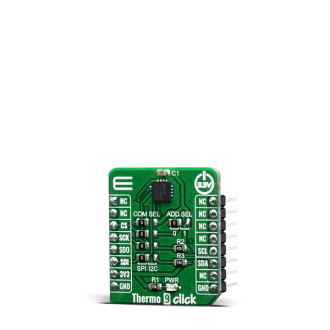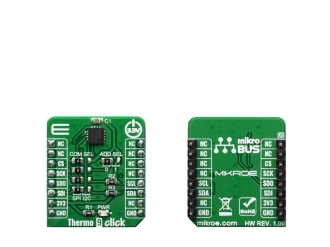
We strongly encourage users to use Package manager for sharing their code on Libstock website, because it boosts your efficiency and leaves the end user with no room for error. [more info]

Rating:
Author: MIKROE
Last Updated: 2020-02-03
Package Version: 1.0.0.0
mikroSDK Library: 1.0.0.0
Category: Temperature & humidity
Downloaded: 3066 times
Not followed.
License: MIT license
Thermo 9 Click is a Click board equipped with the TSYS01, a digital temperature sensor from TE Connectivity. Given its main features, the Thermo 9 Click, can be used for industrial control, replacement of thermistors and NTCs, heating/cooling systems, and HVAC.
Do you want to subscribe in order to receive notifications regarding "Thermo 9 Click" changes.
Do you want to unsubscribe in order to stop receiving notifications regarding "Thermo 9 Click" changes.
Do you want to report abuse regarding "Thermo 9 Click".


Library Description
The library covers all the necessary functions that enables the usage of the Thermno 9 Click board. It holds functions that allow full control of the device to the user. User can calibrate the device, read temperature or read raw values if necessary.
Key functions:
void thermo9_calibation ( ); - Function resets and calibrates the device in order for it to work properly.float thermo9_read_temp ( ); - Function is used to read temperature in degree centigrade.uint32_t thermo9_read_adc ( ); - Function is used to read ADC data.Examples description
The application is composed of three sections :
temp_val = thermo9_read_temp( );
mikrobus_logWrite( " Temperature: ", _LOG_TEXT );
log_display( temp_val );
mikrobus_logWrite( deg_cel, _LOG_LINE );
mikrobus_logWrite( "---------------------", _LOG_LINE );
Delay_ms( 3000 );
Additional Functions :
Other mikroE Libraries used in the example:
Additional notes and informations
Depending on the development board you are using, you may need USB UART click, USB UART 2 click or RS232 click to connect to your PC, for development systems with no UART to USB interface available on the board. The terminal available in all MikroElektronika compilers, or any other terminal application of your choice, can be used to read the message.